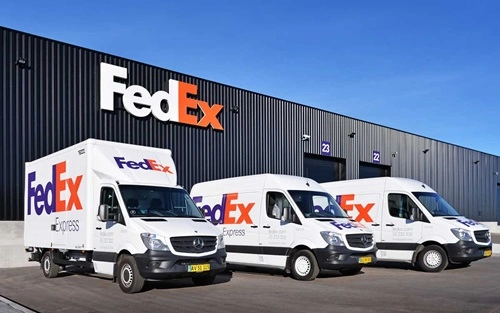FedEx Corporation, a global leader in transportation and logistics, is synonymous with reliable, fast, and efficient delivery services. Since its founding in 1971 by Frederick W. Smith, FedEx has evolved into a multinational powerhouse with operations spanning over 220 countries and territories. FedEx’s diverse business model and its ability to adapt to changing market dynamics have been key to its success. This article explores the FedEx business model and dives into how the company earns money.
Overview of FedEx’s Business Model

FedEx operates on a B2B and B2C logistics business model, offering a wide range of services for shipping, transportation, e-commerce, and supply chain management. Its core offerings include:
- Express Delivery: Time-definite and overnight delivery services for packages and freight.
- Ground Shipping: Cost-effective delivery solutions for businesses and individuals.
- Freight Services: Large-scale shipping for heavy cargo and goods.
- E-commerce Logistics: Integrated solutions for online retailers.
- Supply Chain Solutions: Warehousing, distribution, and inventory management.
The company’s segmented business structure allows it to cater to the varying needs of customers across industries, geographies, and delivery timelines.
Revenue Streams
FedEx generates revenue through multiple divisions and service offerings:
a) FedEx Express
FedEx Express, the company’s flagship segment, is one of the largest contributors to its revenue. This division provides:
- Time-Definite Delivery: Priority overnight and same-day delivery services.
- International Shipping: Cross-border express deliveries, leveraging FedEx’s extensive global network.
- Premium Services: Priority shipping for temperature-sensitive goods, high-value items, and documents.
Revenue is primarily generated through service fees based on factors like weight, distance, speed, and package type. FedEx Express accounts for nearly half of the company’s total revenue.
b) FedEx Ground
FedEx Ground focuses on cost-effective domestic shipping within the U.S. and Canada. Services include:
- Residential Deliveries: Catering to e-commerce and retail shipments.
- Small Package Delivery: Cost-efficient services for non-urgent deliveries.
FedEx Ground earns revenue through fixed charges for parcel handling and additional fees for value-added services like delivery confirmations and signature requirements. The growth of e-commerce has significantly boosted the demand for this segment.
c) FedEx Freight
This segment handles less-than-truckload (LTL) shipments, catering to businesses that ship goods that don’t require a full truck. FedEx Freight provides:
- Priority freight services for time-sensitive shipments.
- Economy freight services for less urgent deliveries.
Revenue in this segment comes from freight shipping fees calculated based on weight, distance, and delivery speed. FedEx Freight is a major player in the North American market.
d) FedEx Logistics
FedEx Logistics offers supply chain management solutions, including:
- Warehousing: Storing inventory for businesses.
- Distribution: Handling the end-to-end supply chain process.
- Customs Brokerage: Assisting businesses with international trade compliance.
- E-commerce Fulfillment: Tailored solutions for online retailers.
Revenue is generated through service contracts with businesses that outsource their supply chain operations to FedEx.
e) FedEx Services
This division provides specialized services like:
- Customer Technology Solutions: Tools and platforms to manage shipments and logistics.
- Marketing Services: Consultancy for optimizing supply chains.
- Billing Services: Customizable billing options for corporate clients.
Revenue in this segment comes from consulting fees and technology subscriptions.
f) E-commerce Partnerships
FedEx collaborates with major e-commerce platforms like Amazon, Walmart, and Shopify to handle their logistics. Revenue is earned through delivery contracts and fulfillment services tailored for e-commerce growth.
g) Retail and Drop-Off Locations
FedEx operates physical locations like FedEx Office where customers can:
- Print, pack, and ship packages.
- Drop off shipments.
- Purchase packaging materials.
These services contribute to the company’s retail revenue stream.
Cost Structure
FedEx’s operations are capital-intensive, with costs spanning multiple areas:
a) Transportation Infrastructure
Operating a fleet of aircraft, trucks, and delivery vehicles is a significant expense. FedEx Express alone has over 700 aircraft and 180,000 vehicles in its network.
b) Fuel Costs
Fuel is one of the most volatile and substantial cost components. FedEx manages this with fuel surcharges to offset fluctuations in prices.
c) Labor Costs
With over 530,000 employees globally, labor costs, including salaries, training, and benefits, are a major expenditure.
d) Technology and IT Systems
FedEx invests heavily in advanced tracking systems, automation, and AI-driven logistics solutions to improve efficiency and customer experience.
e) Maintenance and Operations
Regular maintenance of aircraft, vehicles, and facilities ensures smooth operations but adds to the overall cost structure.
Key Strategies for Revenue Growth
FedEx employs several strategies to maintain its leadership and drive growth:
a) E-commerce Focus
The surge in online shopping has been a significant growth driver. FedEx is enhancing its delivery capabilities to cater to rising demand, including next-day and same-day deliveries.
b) Expanding International Operations
FedEx is strengthening its presence in emerging markets like India, China, and Southeast Asia. Its robust international network positions it to capitalize on global trade growth.
c) Digital Transformation
Investments in technology, such as real-time package tracking, predictive analytics, and robotics, enable FedEx to optimize operations and enhance customer satisfaction.
d) Sustainability Initiatives
FedEx is working toward carbon neutrality by 2040. Its sustainability efforts, including investing in electric vehicles and fuel-efficient aircraft, appeal to environmentally conscious customers and reduce long-term costs.
e) Value-Added Services
By offering specialized services such as temperature-controlled shipping for healthcare products and e-commerce fulfillment solutions, FedEx taps into high-margin opportunities.
Challenges and Opportunities
Challenges
- Competition: FedEx faces competition from rivals like UPS, DHL, and Amazon Logistics.
- Economic Uncertainty: Global trade slowdowns and inflation impact shipping volumes and costs.
- Rising Fuel Costs: Volatility in fuel prices can affect profitability despite surcharges.
Opportunities
- Healthcare Logistics: Expanding in areas like vaccine distribution and pharmaceutical transportation.
- Small Business Solutions: Targeting SMEs with customized logistics and shipping plans.
- Global Trade Recovery: As global trade rebounds, FedEx stands to benefit from increased shipping volumes.
Financial Overview
As of recent financial reports, FedEx has shown robust revenue growth, driven by e-commerce demand and improved performance in its Ground and Freight segments. Despite challenges like rising costs and economic headwinds, the company has maintained profitability by focusing on operational efficiency and strategic expansion.
Conclusion
FedEx’s diversified business model, built on a mix of express delivery, ground shipping, freight services, and supply chain solutions, ensures consistent revenue generation. By leveraging its global network, technological advancements, and customer-centric approach, FedEx continues to lead the logistics and transportation industry. As the e-commerce boom persists and global trade recovers, FedEx is well-positioned to capitalize on emerging opportunities while maintaining its stronghold in the market.

